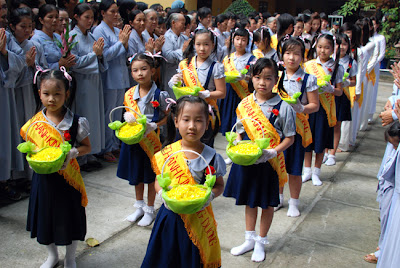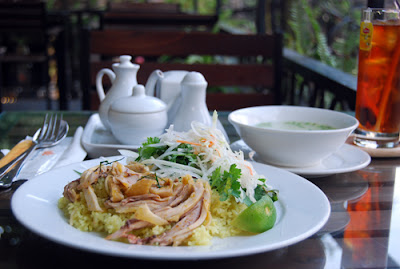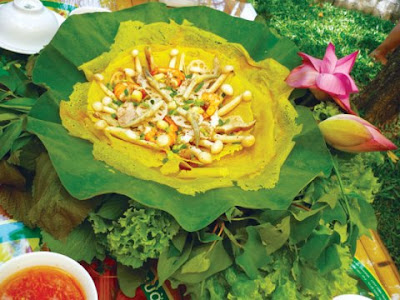Com Hen (Rice with baby clams)
Com Hen is a dish served at room temperature, made with mussels and leftover rice. It is a complicated recipe that includes sweet, buttery, salty, sour, bitter and spicy flavors. .
.png)
BANH CUON (VIETNAMESE STEAMED CREPE)
Banh Cuon is among Hanoi´s most popular food, which is mainly served for breakfast. Despite its prestige among local, not many tourists come to know about this specialty..

Goi cuon (Fresh spring roll)
If you are seeking for a novel dish that is certain to help you stay away from fat or cholesterol but incredibly delicious on its own, do not miss the chance of a lifetime enjoying authentic goi cuon in Vietnam.
.jpg)
Thursday, August 30, 2012
"Vu Lan" Festival in memories
Every year, when Vu Lan festival coming, I am almost moved to tears by my parents image, my country. Despite being far away from home but I am always towards my family.
I remember during Vu Lan festival (the seventh month of the lunar calendar), my mother did offerings for ancestors. There was many times i wondered what the meaning of this festival is, my mother told me that this ceremony was original from long time ago, to feed the hungry ghosts, to pray for their salvation and also a way for people to meet their compassionate filial duty.
According to the traditions, Vietnamese families put out offerings and burn incense for the dead. When the incense burns out (and the spirits have “feasted” on the offerings) children are allowed to eat the fruit and other food on the altars.
As I was small, I just thought simply that a ceremony for ancestor, but now when I grow up, I realized how meaningful it is to express their gratefulness and appreciation towards mothers. I looked at the people flocking to pagodas, some wearing red roses( because their parents are alive), some white roses (because their parents have passed away). At that time, I missed my mother so much. Whatever I do, she supports me and gives advice, whenever i am weak, she is always by my side, to care, to encourage me. I know that wherever I am, she will pray for me with best wishes. Nothing can compare with all love of my mother.
We can never reciprocate our parents favour but always remembering and having a good life will be gratefulness, happiness to our parents.
Vu lan Festival
The good deeds of Father are as great as Mount Thai Son
The virtue of Mother is as bountiful as spring water gushing from its source.
I cant forget Vietnamese vegetarian dishes that my mother used to do in this day with my help
Vietnamese Vegetarian Salad (Goi chay)
(by thekitchn)
Ingredients: Serves 6
1 pound extra firm tofu
Vegetable oil
1/4 cup fresh lemon juice
1/8 cup soy sauce
1 clove garlic, finely chopped
1 serrano or Thai bird pepper, deseeded and finely chopped
1 head green cabbage, shredded
2 carrots, peeled and shredded
Large handful of herbs (basil, mint, rau răm if available), coarsely chopped or torn
Rice noodles (optional)
1/2 cup peanuts, crushed
Direction:
Cut tofu into bite-size pieces and press between clean kitchen towels or paper towels to rid excess water. Heat oil in a skillet and fry tofu until golden brown. Drain excess oil.
In a large bowl, combine lemon juice, soy sauce, garlic, and chili pepper. Add cabbage, carrots, herbs, and tofu to the bowl and toss to combine. Let sit for at least 15 minutes or refrigerate for up to a day before serving.
Serve the salad by itself or over cooked rice noodles and sprinkle with peanuts.
Tuesday, August 28, 2012
Pho (Vietnamese Rice Noodle)
No matter what time day or night, a steaming bowl of pho noodle soup is never hard to find in Vietnam. Just as pad thai in Thailand, pho is Vietnam's unofficial national dish exported with pride all over the world.
Pho consists of flat rice noodles in a light, meat-based broth. The dish is usually accompanied by basil, lime, chili, and other extras on the side so that eaters can season the soup to their own taste. The balanced tastes of sweet, salty, spicy, and citrus are highly contagious; pho usually becomes an instant favorite for anyone visiting Vietnam!
Pronounced something like "fuuuh" with a drawn-out vowel, pho is difficult for Westerners to say correctly because of the tone. Luckily, pho is easier to eat than to pronounce. Traditionally, pho noodle soup was eaten by Vietnamese people for breakfast and sometimes lunch, however both locals and foreigners alike can be found hunched over steaming bowls of pho at street carts throughout the night.
Some squeamish eaters may balk at authentic pho which is made from beef bones, tendons, tripe (stomach), fat, and sometimes ox tail. Bones and lesser-quality cuts of meat are simmered for hours to produce the soup broth. With pho's popularity, many chain restaurants catering to tourists now omit ingredients that may frighten business away. Broth is commonly made from beef, pork, or chicken bones; only lean pieces of meat are added.
To keep up with the eating trends of tourists, vegetarian and tofu pho can now be found in big cities such as Hanoi, Hue, and Ho Chi Minh City.
The broth used in pho preparation is thin and light, with a slight flavor provided by cilantro, onion, ginger, and sometimes cinnamon. The key to enjoying a tasty bowl of pho is to toss in the ingredients given to customers on the side. Practices vary between eateries, but most include bean sprouts, basil leaves, hot peppers, green onions, and a lime wedge on the side.
Ingredients and styles of pho noodle soup vary by region throughout Vietnam. Ga typically means that the dish contains chicken; bo means the dish is prepared with beef.
Monday, August 27, 2012
Com Ga (Hoi An Chicken Rice)
Rice in Hoi An is a very typical dish of this ancient city, and yet very different from others chicken rice in other places in the same province of Quang Nam or Da Nang. While Northern Vietnamese people like to eat the whole piece of boiled chicken thighs or chest, Hoi An people have their own way to make the chicken unforgettable with customers.
Boiled chicken is cut or torn into smaller slices, seasoned with spices like salt, pepper, chilli and Vietnamese coriander - the main factor that makes the dish savory. Combine perfectly with chicken slices, the golden rice made in pilaf form complete the wonderful dish. The rice in this set is cooked with chicken broth, with a dash of fresh turmeric to give it a glossy yellow colour. The small bit of greasiness promises a memorable savour to diners.
The full dish is served with sliced mint leaves and onions to add on to the taste of chicken and spices, and the famous chilli sauce is poured evenly over the dish to create the familiar spicy element in Central Vietnam cuisine. A chicken rice dish surely can help visitors to cure their hunger and make them remember the place for years.
BANH XEO (VIETNAMESE CREPE)
BANH XEO (VIETNAMESE CREPE)
Banh xeo” is Vietnamese style crepe with whole shrimp, thinly sliced pork and bean sprouts.
Like the salad roll, the “banh xeo” is a do-it-yourself dish that involves the messy but delicious process of wrapping the crepe in lettuce with cilantro and basil. Though the filling might fall out on your table, you will be completely lost in the crispy, warm combination of lettuce and crepe, and the attentive staff will happily clean up after you.
“Banh xeo” is prepared differently throughout the country. Tourists traveling about in Vietnam are sure to encounter a different recipe, and sometimes even a different name, for “banh xeo” depending on which region and province they are visiting.
These are a pale yellow spice Vietnamese style crepe. One piece on the bottom, and another on top encase what is usually a salad consisting of been sprouts, prawns, boiled pork, taro and carrot. Drenched in fish sauce, and you have a deliciously messy slice of fine pleasure. The dish is round, and you cut it into slices, like a pizza, so it resembles a triangle on the main platter, but usually by the time it arrives on your plate, it could resemble anything really.
In the Southern region, the “banh xeo” is the size of a large dish and yellow in color due to the employment of turmeric powder. The Southern people always add coconut milk to the rice flour to make the crepe extra delicious. The crepe is stuffed with bean sprouts, mung beans, shrimp and pork. A sweet and sour fish sauce and fresh vegetables are used as accompaniments.
In the Central region, “banh xeo” cooks make a smaller crepe that is white in color. In Hue, the crepes are called “banh khoai”, which is similar to “banh xeo”, but smaller in size and stuffed with fennel, sour star fruit, green banana and a thick soy sauce.
In addition to selling the crepes to patrons, vendors also prepare them en masse for birthday parties and festivals. Northern preparations of “banh xeo” are similar to the ones down south, but include special fillings like slices of Indian taro and manioc. In some regions, “banh xeo” is prepared thick, but Southern crepes are characteristically thin, crispy and served fresh out of the frying pan. The secret to extra-thin crepes is a deep frying pan and a quick wrist to coat the frying pan with the batter before it starts to set.
www.culinaryvietnam.com - Vietnam culinary tour









.jpg)
 7:46 PM
7:46 PM
 Unknown
Unknown























